|
|
|
|
5-M2
Yukie Kodama
|
|
|
|
|
|
5-M1
Azusa Ohtsuki
|
|
|
|
|
|
5-M1
Mutsuko Sato
|
| |
| |
| |
|
|
|
Members who did reach on the Umedagawa
River.
Hideaki Ohyama Yuhya Ojima
Yukie Kodama Mutsuko Satoh Azusa Ohtsuki
|
|
We
had been learning about environmental issues through the course of YMP,
Young Masters Program, which was presented by Lund University, and IEEE
in Sweden. We have learned our environment is now in danger in many respects.
As the summary of this course, an international conference on environmental
issues was held in Alexandria in Egypt. We had discussed what we should
study for our presentation for a long time. When we asked ourselves what
we could do for our environment, we found our theme of presentation. We
decided to report our school's activity to clean up the Umedagawa River.
There are about 5,000 students at Sendai Ikuei Gakuen High School and
Shukoh Middle School. We are involved in many activities to keep the environment
clean. Cleaning up the Umedagawa River is one of them. Every spring and
autumn, we pick up garbage along the Umedagawa River with local community
members. This activity has continued since 1992. We reported on the history
of the river, the challenge of the residents to regain the clean river and
the results of our investigation of the present state of the Umedagawa River.
Before we went to Alexandria, we had to do many things. |
| |
The Field
Working
First, we needed to know how our school had participated in the cleaning
up activity. It was in 1992 that our school began to clean up the Umedagawa
River with the local residents. In those days the Umedagawa River was very
polluted. In that year, to make the environment better, Umedagawa Cleanup
Association was set up by Mr. Tomonobu Ikeda, who is one of the old boys
of our school and now is a member of Sendai city assembly. Mr. Ikeda told
us a lot about the Umedagawa River, showed us photos of the river, and told
us how it is important to take action to save the natural environment by
ourselves before we rely on others like the government. He became a great
help for us and we went to Alexandria with him.
After we got some advice from Mr. Ikeda, we visited the Sendai city office
to research what our local government does to save the environment and got
some data to show change in the river environment. The Umedagawa River played
a very important role in daily life of the residents, but this river was
once very polluted. The data the city office gave us shows that the environment
of the Umedagawa River has greatly improved with the efforts of residents
around the river and the local government.
We thought we should investigate the water quality of the River by ourselves.
So we went there and took some water to check the BOD, biochemical oxygen
demand, value. We used BOD as a chemical rate to show the water quality
of the river. BOD is the most common chemical method to determine the water
quality of a river. River water gets dirty because of organic matters produced
by microbes. Microbes in rivers consume the oxygen dissolved in water. In
short, we can discover the amount of organic matters by measuring consumptions
of dissolved oxygen on condition that the sample water does not touch the
air. We investigated what kinds of creatures are living there, too. We found
some leeches and so on.
As we get to know the Umedagawa River and find the meaning of our cleaning
up activity, we wondered how our friends thought of the cleaning up activities.
We sent out a questionnaire about the Umedagawa River to 4th graders and
5th graders of Shukoh Middle School.
With these preparation, we left for Egypt on September 8th. It was the beginning
of 10 days great experience. |
| |
|
|
|
At Alexandria
Our plane arrived at Cairo Airport at midnight on September 9. Next day
we did sight in the city of Cairo, visiting museums, pyramids, etc. On September
10, we left Cairo for Alexandria with the other participants from other
countries by bus. The bus trip was tiring but fun. The foreign participants
were cheerful, and we traveled all the way talking, singing, and laughing.
In Alexandria, we stayed at the dormitory of Arab Academy for Science
and Technology. When we unpacked our suitcase, rhythmical sound and some
cheerful voice came into our room from outside. We went out to see what
was going on, and found our hosts dancing to their drum. There were also
many participants dancing. We joined them and enjoyed dancing with them
till late.
Next day the conference started. We chose to join the Water Management
Section. During the daytime, we listened to lectures and took part in discussions,
while evening we could have a good time communicating with the students
from various countries. They were at our age, so we could easily make friends
with each other.
In the first evening, we had a party and every group of the participants
performed something. Some groups danced folk dance, and some sang songs
of their own country. We, Japanese group, wore yukata, gave pieces of paper
and showed how to fold origami. Our performance was different form other
groups', so it received favorable review.
|
| |
|
|
|
Presentation
The day our presentation was the second day of the conference. We made
a presentation using computer. Here, we introduce the abstract of our presentation.
1. Challenge to regain the clean river
The activity to clean up the Umedagawa River started in 1992. When the
group of local residents and our school first began cleaning up the river,
the amount of garbage was very large. In these thirteen years this campaign
has become much larger. More than one thousand people, including the many
local office workers and the residents living near the river, take part
in this campaign every year.
Since 1993, in July, the association has held a festival called "Love
the River Festival" in order to show thanks for the blessing of the
river and to give the residents a chance to know more about it.
The aim of the Umedagawa Cleanup Association is to sustain the Umedagawa
River. Mr. Tomonobu Ikeda found that it was very important for us to clean
the river for future generation. Our activities are beyond just cleaning
up: We plant many flowers so that we can commune with nature; we adopt methods
of river maintenance used one hundred years ago and we have local government
involved in bank protection works on the basis of these activities.
Umedagawa Cleanup Association was awarded by the Ministry of Construction
(the present Ministry of Land, Infrastructure and Transport) in 1998. This
award was a great honor for all members of Umedagawa Cleanup Association.
We were glad that our hard work was officially praised.
Our school has joined the activity as a vanguard of the neighboring schools
since the association was established. In 2001, as a result of our activity,
the amount of rubbish was reduced to about one forth compared to that in
1992. Of course, this spring, we picked up the garbage with the other members
of the association.
2. The result of the questionnaire
We sent out a questionnaire about our cleaning up activity to our classmates.
According to the results, many students think that cleaning the river is
necessary. In my school, the students have participated in the clean-up
campaign since they were1st graders. When we asked what they thought of
the present state, compared to that of a few years ago, almost all students
said that the amount of rubbish has not changed or been reduced.
However, the Umedagawa Cleanup Association is not very well known to them.
The members of the Umedagawa Cleanup Association clean up the river with
us. We hope the activities of this association will become better known
in the future.
However, the Umedagawa Cleanup Association is not very well known to them.
The members of the Umedagawa Cleanup Association clean up the river with
us. We hope the activities of this association will become better known
in the future.
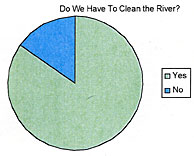
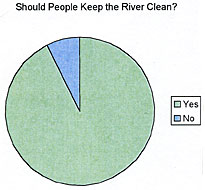
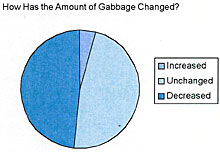
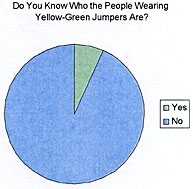
3. The History of the Umedagawa River
The Umedagawa River first appeared in the history when Masamune Date,
the first lord of Sendai, started to irrigate the old city of Sendai in
the beginning of the 17th century. When he built the castle, the Hirosegawa
River was the main water source of the city, but there was no facility for
irrigation. He built an irrigation canal that connected the Hirosegawa River
with the Umedagawa River. This canal called "Yotsuya Yosui," Yotsuya
irrigation, was how the city gained water.
The water poured by Yotsuya Yosui was used in daily life by the residents
of Sendai. It was not only used for cooking, cleaning, farming and dying
clothes but also saved as water supply for fire fighting use. It was also
used as a ditch.
Though this irrigation network ran through the city area, the water was
very clean. The residents made many efforts to keep the canal clean: they
were forbidden to throw garbage into the canal. They cleaned up the canals
twice a year and along the river. They planted Japanese cedars that aid
in purifying water. Sometimes Sendai got hit with the brunt of heavy rains,
and each time the city was flooded, the people dug ditch so that the water
ran into the Umedagawa River. At the same time, the pollutants in the ditch
were washed away. Heavy rains played a role in cleaning the river.
The water in the city was kept clean by the efforts of the people. Yotsuya
Yosui supplied the residents with plenty of water.
After 1867, Yotusya Yosui was gradually reclaimed. Instead of it, ditches
and small channels were built, but they did not work well. The sewage water
could not be cleaned by rainwater any more, so the rivers of the city gradually
became dirty. The wastewater from the residents was poured into the Umedagawa
River, so this river had been very dirty till the sewage system was introduced.
Now we cannot see any trace of the old irrigation in the town.
The present Umedagawa River is about 12km long. Once it was polluted,
but now the water quality is better than before. We collected the past chemical
and biological data and investigated the present situation by ourselves.
We took sample water at Karekibashi Bridge, Sugitobahi Bridge, Ootamibashi
Bridge and Fukkudabashi Bridge. At Shinden-Ohashi Bridge, we caught some
insects.
4. Checking the BOD Value
Fig.1 shows the change of the BOD rate of the Umedagawa River every year
form 1967 to 2004.
The BOD rate decreased largely in 1970. This is because Japanese government
established the law to forbid the factories throwing their wastewater into
river.
Fig.1 has too large-scale vertical line, to show what was happening after
1970, so Fig.2 has a smaller scale.
BOD rates decreased from 1975 to 1981. This is because the water flow increased
at this time and thinned down the pollution. We do not know why the flow
increased because it happened about 20 twenty years ago and now we could
not access official record to explain it. From 1977 to 1997, the sewerage
system was built along the Umedagawa River, so that the dirty water from
houses did not drain into the river and the BOD rate became lower.
We measured BOD rates for 2004. In fact, the rates are inaccurate. There
are two reasons. One is the temperature of the water. When we measured,
the water temperature was 30 degrees Celsius, 86 degrees Fahrenheit. The
other is the different process for measuring water. The proper way to measure
the BOD rate is to measure every month and take the ninth highest value
in order to avoid taking an exceeding value, but we measured only twice,
so our results are not as precise. When the river rose after heavy rain,
the BOD rate of the water that was taken at Fukudabashi Bridge and measured
0. Anyway, it is true the rates are low.
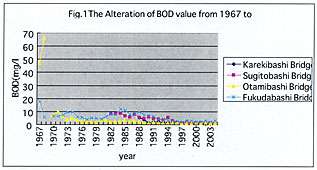
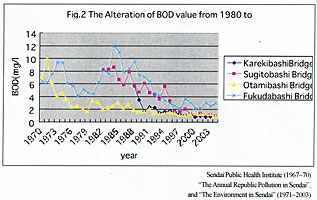
5. The Indicated Species in the Umedagawa River
The words, indicated species, mean creatures living in the river that
can tell us what the environment is like. Creatures have their own habitat
depending on their preys. So, we can learn about the environment of a specific
place by searching for what kind of species lives there.
In chart 1, a circle means the species found in the Umedagawa River and
the ones painted out means that the number of creatures found there was
large. "A+B" or "C+D" in the columns of water quality
means the species live in interspaces between A and B, or C and D.
The research done by the Office of Public Health of Sendai in 1975 shows
us the water of Umedagawa River near by Ootamibashi Bridge was murky (C)
at that time, as erpobdella, chironomid and tubifex were found. The same
research was done in 1977, and found the same species as in 1975, so the
water quality did not change. In those days, the river smelt very bad.
We examined indicated species near Ootamibashi Bridge this July. We found
cheumatopsyche and leeches in a place where the water flows rapidly, and
we found leeches in a place where the water flows slowly. Cheumatopsyche
live in a little murky water and leeches live in murky water. So, the water
quality is in the middle of a little murky and murky. When we caught the
insects in the Umedagawa River, the river did not smell bad and there were
some people talking or eating on the riverside.
Chart 1. Indicated Species and the Water Quality
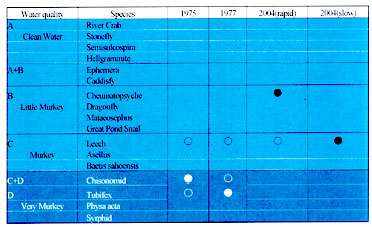
6. Conclusion
We have looked at the Umedagawa River from the points of history, chemical
research, and biology. The river was kept clean by the effort of people
during Edo Era, but when people began to neglect it, the river got polluted.
Now the river is beginning to become clean again. The water quality is getting
better and its biodiversity is getting rich. Some waterfowls have returned
to the river.
Through this study, we learned what is important is to make efforts in
order to keep the environment clean. We can not only destroy the environment
but also protect and regain it. We will keep on doing what we can do to
protect the environment.
Umedagawa Cleanup Association began collecting trashes though they were
not paid. We can change the environment better if we get together and deeply
communicate each other. |
| |
|
|
|
At the end of our trip
Our presentation was very successful and a Greek teacher praised our report.
To our great joy, our presentation won the first prize in the Water Management
Section. We were supposed to present our report on the last day of the conference
with the first winners of other sections, but due to the change of the schedule,
we could not do so. It was very disappointing, but it could not be helped.
During these 10 days, we could make friends with the students from foreign
countries. We could not have met these people if we had not joined this
conference. Every night we talked using English and gesture until midnight.
Apart from the conference, we had a chance to visit many interesting site.
For the first time, we saw pyramids at hand. It was amazing experience for
us. We were deeply impressed by the fact that such huge structures were
built thousands of years ago.
Through this travel, we learned about not only environmental problems
but culture of the other countries. We would like to thank Mr. Ikeda and
Aki Obata, who went to Alexandria with us, for their great help. And thank
our parents Shukoh teachers and for their advice and support. And finally,
thank Mr. Takehiko Katoh, the Principal, for giving us the opportunity to
participate in this conference. |
| |
|
 |
|
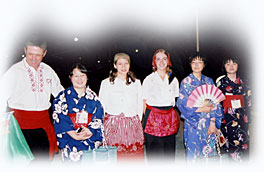 The
Environmental Issues of the Umedagawa River
The
Environmental Issues of the Umedagawa River The
Environmental Issues of the Umedagawa River
The
Environmental Issues of the Umedagawa River